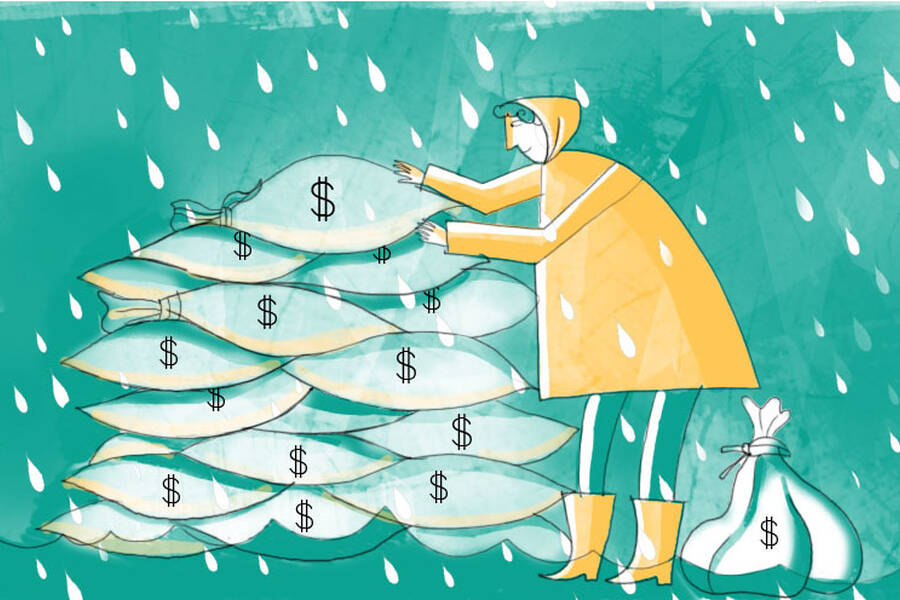Finance & Accounting Sep 6, 2022
What Happens to Innovation During an Economic Crisis?
The Great Depression hastened the end of the independent inventor—but not all was lost.

Riley Mann
When a financial crisis hits, the general view is that innovation will tank. Companies are struggling, funding dries up, and projects get cut.
But Filippo Mezzanotti, an associate professor of finance at Kellogg, and his colleagues wondered if more nuanced dynamics were at play. For instance, crises might prompt workers and firms to reconsider their long-term objectives, think deeply about which projects are most valuable, or revamp their operations.
While innovation might still drop, other factors “could potentially reduce the overall negative impact,” he says. And perhaps those less obvious trends “are actually what persist as things normalize.”
In a new study, Mezzanotti and coauthors focused on the Great Depression, examining patents by inventors and companies during that time period. The researchers found a deep decline in independent inventors’ patents, which appeared to be driven by a lack of local funding in counties that were hit hard by the economic crisis.
But large companies in those distressed areas better weathered the crisis and may have actually benefitted from it. These patterns suggest that independent creative thinkers didn’t vanish; many of them found jobs at firms, where they continued to innovate.
Independent inventors “did dramatically suffer,” Mezzanotti says. But moving to companies may have saved some of their ideas. “Reallocation was an important force,” he says.
The research partly explains why independent inventors, once a common source of innovative ideas, no longer play as prominent of a role; today, most of that creative activity happens at firms. While this shift likely would have taken place at some point anyway, the Depression might have kickstarted the trend.
Economic crises “could be catalysts for very deep changes,” Mezzanotti says.
Historical Angel Investors
Typically, researchers have pointed to technological trends to explain the shift from independent to firm-based inventing. Technologies that became prevalent over the 20th century required more capital investment and bigger teams, thus favoring companies as hubs of innovation.
Mezzanotti and his colleagues, Tania Babina at Columbia University and Asaf Bernstein at the University of Colorado Boulder, didn’t reject that idea. But they wondered how much the Great Depression contributed to the shift. When the researchers looked at broad trends in patent data during the first half of the 20th century, they found that the number filed by independent inventors plunged in the 1930s and didn’t recover. In contrast, the decline in firms’ patents was much smaller and shorter-lived.
Furthermore, they saw a drop across all technologies around the onset of the Depression. If the decline in independent activity was entirely driven by technological trends, the team would have expected to see declines happen at different times depending on the type of technology. That pattern hinted that “there was potentially more to the story than just the technology story,” Mezzanotti says.
Historical accounts suggested that the Depression made it harder for independent inventors to get funding. Unlike companies, which often got loans from banks, individual inventors usually sought support from local wealthy businessmen, similar to the way that startups look for angel investors today. If businessmen had lost money in the crisis, they might have become reluctant to invest in new projects.
Economic crises “could be catalysts for very deep changes.”
— Filippo Mezzanotti
Bank loans to companies also likely dried up, but firms could draw on earnings from existing products to get by, Mezzanotti says. Independent inventors who scrounged up money one project at a time might have lacked a reliable source of income to fall back on.
A Blow to Young Inventors
The Depression crushed the economy, but the crisis didn’t strike with the same force everywhere. So, to investigate their hypothesis, Mezzanotti’s team analyzed county-by-county Federal Deposit Insurance Corporation (FDIC) reports on banking suspensions in the United States from 1920 to 1936.
The researchers identified counties that experienced more severe distress, which they defined as having reported some bank deposit suspended from 1930 to 1933. The bank suspensions were a proxy for local economic woes, which might have affected wealthy businessmen’s ability to invest in inventors’ projects.
During the Depression, independent inventors’ patents dropped by 13 percent more in the highly distressed counties than they did in the less distressed counties. And that gap continued for seven decades. “There is no recovery afterward,” Mezzanotti says.
Using U.S. Census data from 1910 to 1940, the team could find some basic demographic information about these inventors. They found that younger, less experienced inventors suffered from a bigger decline in patenting. Seasoned inventors might have had more personal funds to draw on or built enough of a reputation to continue securing funding.
Among firms, the level of banking distress in their county didn’t seem to affect patenting activity. But a difference emerged when the team split companies into newer and older ones.
Within new firms, total patents dropped by 3.4 percent more in highly distressed counties than in less distressed counties, perhaps because they relied on funding channels similar to those of independent inventors. At older firms, patents actually increased marginally in more distressed areas, with most of the increase coming from larger companies. This pattern suggested that innovation talent had somehow been shuffled; perhaps independent inventors were moving out of their home laboratories and into established firms.
Going Corporate
To look into this possibility, the researchers focused on inventors who had patents granted both before and during the Great Depression—in other words, they had somehow managed to continue innovating through the crisis. Among this persistent group, inventors who lived in distressed counties were more likely to move to a company; their names were still listed on their later patents, but the patents were assigned to firms. Without support from their usual investors, perhaps these inventors saw better prospects in a corporate environment.
“It’s not that these independent inventors necessarily disappeared,” Mezzanotti says.
Were these moves good or bad for innovation overall? Mezzanotti can’t make a definitive judgment.
But the team did analyze how the quality of patents changed, using the citations that each patent received as a rough indicator. During and after the Depression, the average number of citations per patent was higher in more distressed counties than in less distressed counties. Much of the decline in independent patenting seemed to have come from a reduction in lower-quality ideas.
Society might have still lost out on some potentially great innovations. But the results suggest that “if you were an inventor with a very high-quality idea, the effect there was much more limited,” he says.
Radical Shifts
Finally, Mezzanotti and his colleagues looked more closely at the types of patents affected. The Depression seemed to have acted as an “equilibrium switch” that pushed innovation into firms. If that were the case, the trend should be even stronger in situations where companies had an advantage over individual inventors.
For instance, some emerging technologies might be more effectively developed by teams, which would be easier to assemble within a firm than on one’s own. An independent inventor working without the support of colleagues could have a harder time executing a complex idea.
This expectation was borne out in the data: in distressed counties, independent patents with solo inventors tended to decline more than independent patents filed by teams. In other words, the type of inventing activity that was going “out of fashion”—due to an increasing focus on technologies that required collaboration—took a bigger hit.
Similarly, independent inventors would be at a disadvantage when working on projects that required substantial capital investments. “This is where the firms are becoming superior over time,” Mezzanotti says. As expected, independent patents declined more in technologies used in industries that relied heavily on external financing.
The researchers also ruled out a couple of alternative explanations. One could imagine that government interventions, intended to boost innovation after the crisis, favored big firms over individuals. But the long-term decline in independent inventors’ patents wasn’t any more pronounced in industries with more government involvement; in fact, the drop was smaller for those fields than for other technologies.
Nor did the trends seem to be driven by inventors leaving distressed counties for areas that were faring better. Based on census data, “it didn’t look like these people moved away,” Mezzanotti says.
The study illustrates how economic crises can transform the landscape of innovation, forcing changes to unfold much more quickly than they would have in calm periods. “These are times when people are forced to rethink the way they’re organizing their life, their business, or their activity,” he says. To take a modern example, videoconferencing probably would have gained momentum over the next several decades, but the COVID-19 pandemic fast-tracked the technology into widespread use.
The Great Depression was a unique event in U.S. history, and its lessons can’t be mapped directly onto recent or ongoing economic downturns. The trends his team saw are not a “recipe” for the next crisis, Mezzanotti says. But the research highlights that, during these extreme events, there may be other forces at work beyond a straightforward decline.
“There’s going to be winners and losers,” he says. “We need to have a more nuanced view of crisis.”
Roberta Kwok is a freelance science writer in Kirkland, Washington.
Babina, Tania, Asaf Bernstein, and Filippo Mezzanotti. 2022. “Financial Disruptions and the Organization of Innovation: Evidence from the Great Depression.” Working paper.



